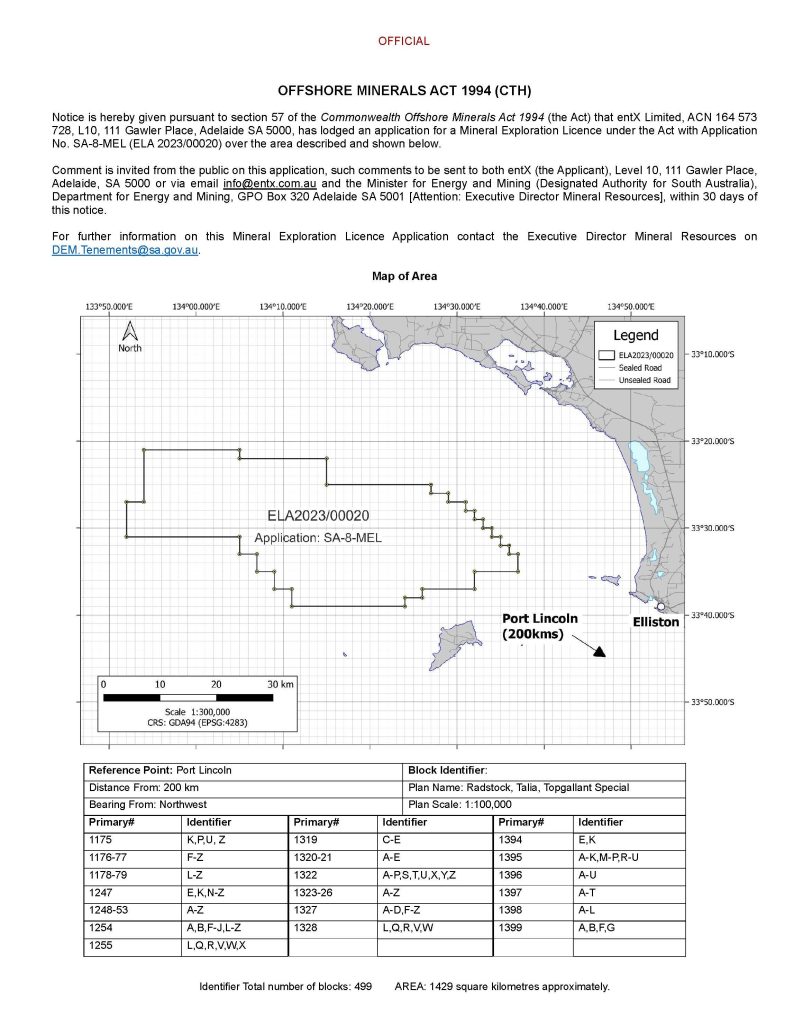Western Eyre Project
The full application to the designated authority for the Offshore Minerals Act 1994 (Cth)

FREQUENTLY ASKED QUESTIONS
These frequently asked questions have been developed to assist the community with the understanding of the recent application by entX Limited (in accordance with the Commonwealth Offshore Minerals Act, 1994) to undertake scientific exploration on the size and nature of the Halite (salt evaporite) deposit located, approximately 75kms to the west of Elliston, South Australia.
What is a Mineral Exploration Licence?
A mineral exploration licence covers the exploration phase of a project and gives the holder exclusive rights to apply for further approvals to undertake exploration-related activities.
A mineral:
• is defined as a naturally occurring substance or a naturally occurring mixture of substances.
• may be in the form of sand, gravel, clay, limestone, rock, salt evaporites, shale, oil-shale and coal.
Minerals do not include oil and gas.
What is the difference between Australian (Commonwealth) and South Australian (State) waters?
Australian waters are the offshore area beyond coastal waters, starting 3 nautical miles from the shoreline (or straight baseline). To explore for minerals in Australian waters, you must obtain an Offshore Mineral Exploration Licence.
Mineral exploration activities can only happen in Australian waters with approval from the relevant Joint Authority. The responsible federal minister and the relevant state or Northern Territory minister generally make up the Joint Authority.
Why are entX Limited looking to apply for a mineral exploration licence in Commonwealth Waters?
Following on from previous scientific investigations conducted by Geoscience Australia on the offshore salt evaporite deposits to support underground hydrogen storage within the geological formations on the Western Eyre Peninsula, entX has been actively advancing research work (under our existing South Australian Government Exploration Licences) to quantify the nature and extent of these salt evaporites on the onshore part of the Western Eyre Peninsula.
The preliminary findings of this research activity now require entX to gather further information on the offshore salt evaporite deposits which are located approximately 60-80kms to the west of Elliston and at depths of ~1300-2400m below the seabed.
In order to undertake this research exploration activity, entX must apply to the Commonwealth Government for a mineral exploration license, which ensures there is an appropriate regulatory framework to carry-out the scientific investigative studies in a timely manner.
What are entX looking to do during the four-year exploration licence period?
entX proposes to conduct the following non-intrusive exploration activities in order to fully understand the presence of the salt evaporite deposits within the license application area.
Year 1: Collation, review, and reinterpretation of historic data over known areas of salt within the Kilroo Formation to determine Palaeozoic and Proterozoic stratigraphy. In addition, a geochemical analysis will be undertaken on existing rock samples from the Mercury-1 drillhole to assess the mineral composition of the host rock and salt.
Year 2: Interpret pre-existing 2D seismic data to understand the character of known salt evaporites, including distribution, burial depth, and thickness.
Year 3: Explore the option of either acquiring airborne geophysical data or reprocessing the pre-existing seismic 2D data to map the potential extension of salt evaporites within the application area.
Year 4: If results from previous exploration phases are encouraging, a decision to continue exploring, via the planning and acquisition of additional data via infill 2D or 3D seismic or other environmentally sensitive methods to confidently define the salt evaporite deposits.
Who regulates activities in the offshore environment for mineral exploration?
The Australian Governments, Department of Industry, Science and Resources regulate offshore exploration mineral activity in Australian waters (beyond 3-nautical miles of the shoreline) under the Offshore Minerals Act 1994.
In partnership with the states and the Northern Territory, the Department of Industry, Science and Resources (DISR) advise the Joint Authority on awarding exploration licences and other titles. DISR also works with the states and Northern Territory to regulate industry activities. The relevant state or Northern Territory also performs the functions of the Designated Authority. The states and territories administer any activity within the first 3 nautical miles of the Australian shoreline.
Where can I find out more information?